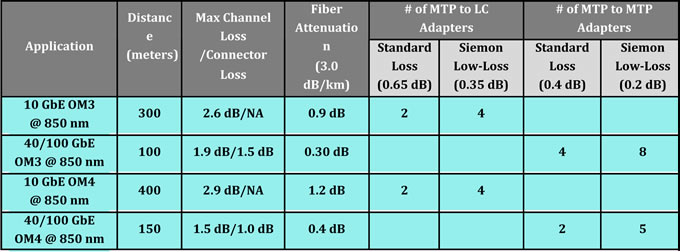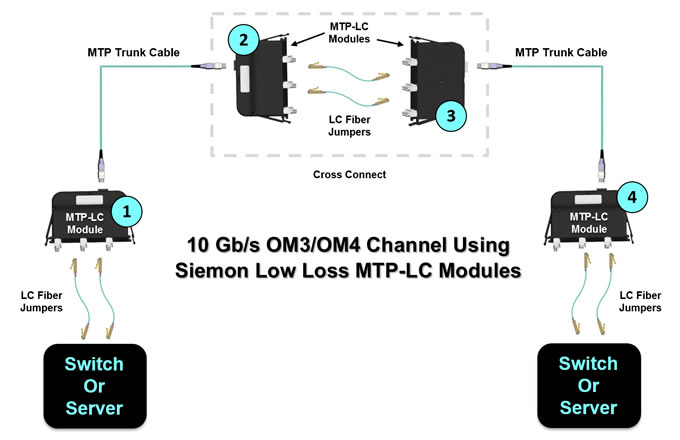July 09, 2014
Low-loss Connectivity For Multifiber Applications
Optical insertion loss budgets are now one of the top concerns among data center managers, especially in today’s large virtualized server environments with longer-distance 40 and 100 gigabit Ethernet (GbE) backbone switch-to-switch deployments for networking and storage area networks (SANs). In fact, loss budgets need to be carefully considered during the early design stages of any data center—staying within the loss budget is essential for ensuring that optical data signals can properly transmit from one switch to another without high bit error rates and performance degradation.

With the length and type of the fiber cable and number of connectors and splices all contributing to the link loss, data center managers are faced with the challenge of calculating each connection point and segment within their fiber channels. Multi-fiber push on (MPO) or mechanical transfer push on (MTP) connectors are rapidly becoming the norm for switch-toswitch connections due to their preterminated plug and play benefits and ease of scalability from 10 to 40 and 100 gigabit speeds. Unfortunately, typical MPO MTP module insertion loss may not allow for having more than two mated connections in a fiber channel, which significantly limits design flexibility and data center management. Low loss, rather than standard loss, MPO/MTP connectors better support multiple mated connections for flexibility over a wide range of distances and configurations while remaining within the loss budget.

Typical MPO/MTP connectors, which are required for 40 and 100 GbE eployments have insertion loss values that range from 0.3 dB to 0.5 dB. Typical LC multimode fiber connectors have loss values that range from 0.3 dB to 0.5 dB. While better than the allowed 0.75 dB TIA value, typical connector loss still limits how many connections can be deployed in 10, 40 and 100 GbE channels. For example, with an LC connector loss of 0.5 dB, a 300-meter 10 GbE channel over OM3 fiber can include only three connectors with no headroom. Having just two or three connections prevents the use of cross connects at both interconnection (MDA) and access switches (HDA).
Due to improvements in connector technology and manufacturing techniques, Fiberstore has succeeded in lowering the loss to 0.20 dB for MTP connectors and to 0.15 dB (0.1 dB typical) for LC and SC connectors, well below the industry standard of 0.75 dB and loss values offered by other manufacturers.
For 10 GbE, Fiberstore low loss LC fiber jumpers offer a loss of 0.15 dB (typical 0.1 dB) and Fiberstore low loss plug and play MTP to LC or SC modules offer a loss of 0.35 dB (typical 0.25 dB). For 40 and 100 GbE, MTP to MTP pass-through adapter plates and MTP fiber jumpers offer a loss of 0.2 dB. These lower loss values allow data center managers to deploy more connection points in fiber channels, enabling the use of distribution points or cross connects that significantly increase flexible configuration options.
Figures 6, 7 and 8 shows some example scenarios for deploying cross connects in 10 GbE and 40/100 GbE channels over OM3 and OM4 fiber using Fiberstore low loss fiber connectivity. In Figure 6, all changes are made at the cross connect with LC fiber jumpers. The switches remain separate and the permanent MTP trunk fiber cables need only be installed once. The cross connect can be placed anywhere within the channel to maximize ease of deployment and manageability.

Figure 7. shows an OM3 40/100 GbE channel with six Fiberstore low loss MTP-MTP pass-through adapter plates and low loss trunks. This scenario offers 0.4 dB of headroom and provides even better manageability and security. All changes are made at the cross connects via MTP fiber jumpers, switches remain separate, and the MTP trunk cables need only be installed once.Once again, the cross connects can be located anywhere in the data center for maximum flexibility. This allows for one-time deployment of high fiber-count cabling from the cross connect at the interconnection switch to the cross connect at the access switch. Adding additional access switches can be accomplished with short fiber runs from the cross connect.
If the loss budget does not permit deploying six MTP to MTP adapters, one option is to deploy MTP to LC or MTP to MTP jumpers from the cross connect to the equipment, depending on the equipment interface. For example, if using OM4 fiber to extend the channel distance to 150 meters, up to five Low Loss MTP-MTP pass through adapters can be deployed.10 Gigabit Ethernet (10GbE) introduces a challenging 2.6-dB insertion loss limit on OM3 fiber cabling. This tight limit has led some industry observers to suggest it is not possible to meet the standard using regular, as opposed to low-loss, MTP cassette. Some have also suggested it is not possible to run fiber cabling the full 300-meter distance specified in the 10GBase-S standard when using MTP cassettes, whether those cassettes are standard or low-loss.
The TIA-568-C.0 standard allows for a maximum 2.6-dB insertion loss and 300-meter length with OM3 fiber cabling systems. While manufacturers frequently submit their copper cables for third-party testing to verify performance that meets or exceeds applicable standards, they typically have not had fiber cabling systems, including OM3, tested. This lack of independent verification can leave designers and operators of OM3 fiber networks uncertain what the true parameters are in designing premises applications.
For example, the maximum insertion loss for MTP-LC cassettes or modules as stated in the TIA specification is 1.5 dB. An unusually complicated–but not extreme–configuration might consist of four cassettes with a total of eight mated pairs. If each of these cassettes was at the headroom limit, then the insertion loss of 6.0 dB would exceed the allowable limit. Some vendors have addressed this possibility by offering low-loss cassettes. These cassettes typically come at a cost premium of approximately 50% over standard cassettes.
Comments are disabled.

With the length and type of the fiber cable and number of connectors and splices all contributing to the link loss, data center managers are faced with the challenge of calculating each connection point and segment within their fiber channels. Multi-fiber push on (MPO) or mechanical transfer push on (MTP) connectors are rapidly becoming the norm for switch-toswitch connections due to their preterminated plug and play benefits and ease of scalability from 10 to 40 and 100 gigabit speeds. Unfortunately, typical MPO MTP module insertion loss may not allow for having more than two mated connections in a fiber channel, which significantly limits design flexibility and data center management. Low loss, rather than standard loss, MPO/MTP connectors better support multiple mated connections for flexibility over a wide range of distances and configurations while remaining within the loss budget.

Typical MPO/MTP connectors, which are required for 40 and 100 GbE eployments have insertion loss values that range from 0.3 dB to 0.5 dB. Typical LC multimode fiber connectors have loss values that range from 0.3 dB to 0.5 dB. While better than the allowed 0.75 dB TIA value, typical connector loss still limits how many connections can be deployed in 10, 40 and 100 GbE channels. For example, with an LC connector loss of 0.5 dB, a 300-meter 10 GbE channel over OM3 fiber can include only three connectors with no headroom. Having just two or three connections prevents the use of cross connects at both interconnection (MDA) and access switches (HDA).
Due to improvements in connector technology and manufacturing techniques, Fiberstore has succeeded in lowering the loss to 0.20 dB for MTP connectors and to 0.15 dB (0.1 dB typical) for LC and SC connectors, well below the industry standard of 0.75 dB and loss values offered by other manufacturers.
For 10 GbE, Fiberstore low loss LC fiber jumpers offer a loss of 0.15 dB (typical 0.1 dB) and Fiberstore low loss plug and play MTP to LC or SC modules offer a loss of 0.35 dB (typical 0.25 dB). For 40 and 100 GbE, MTP to MTP pass-through adapter plates and MTP fiber jumpers offer a loss of 0.2 dB. These lower loss values allow data center managers to deploy more connection points in fiber channels, enabling the use of distribution points or cross connects that significantly increase flexible configuration options.
Figures 6, 7 and 8 shows some example scenarios for deploying cross connects in 10 GbE and 40/100 GbE channels over OM3 and OM4 fiber using Fiberstore low loss fiber connectivity. In Figure 6, all changes are made at the cross connect with LC fiber jumpers. The switches remain separate and the permanent MTP trunk fiber cables need only be installed once. The cross connect can be placed anywhere within the channel to maximize ease of deployment and manageability.

Figure 7. shows an OM3 40/100 GbE channel with six Fiberstore low loss MTP-MTP pass-through adapter plates and low loss trunks. This scenario offers 0.4 dB of headroom and provides even better manageability and security. All changes are made at the cross connects via MTP fiber jumpers, switches remain separate, and the MTP trunk cables need only be installed once.Once again, the cross connects can be located anywhere in the data center for maximum flexibility. This allows for one-time deployment of high fiber-count cabling from the cross connect at the interconnection switch to the cross connect at the access switch. Adding additional access switches can be accomplished with short fiber runs from the cross connect.
If the loss budget does not permit deploying six MTP to MTP adapters, one option is to deploy MTP to LC or MTP to MTP jumpers from the cross connect to the equipment, depending on the equipment interface. For example, if using OM4 fiber to extend the channel distance to 150 meters, up to five Low Loss MTP-MTP pass through adapters can be deployed.10 Gigabit Ethernet (10GbE) introduces a challenging 2.6-dB insertion loss limit on OM3 fiber cabling. This tight limit has led some industry observers to suggest it is not possible to meet the standard using regular, as opposed to low-loss, MTP cassette. Some have also suggested it is not possible to run fiber cabling the full 300-meter distance specified in the 10GBase-S standard when using MTP cassettes, whether those cassettes are standard or low-loss.
The TIA-568-C.0 standard allows for a maximum 2.6-dB insertion loss and 300-meter length with OM3 fiber cabling systems. While manufacturers frequently submit their copper cables for third-party testing to verify performance that meets or exceeds applicable standards, they typically have not had fiber cabling systems, including OM3, tested. This lack of independent verification can leave designers and operators of OM3 fiber networks uncertain what the true parameters are in designing premises applications.
For example, the maximum insertion loss for MTP-LC cassettes or modules as stated in the TIA specification is 1.5 dB. An unusually complicated–but not extreme–configuration might consist of four cassettes with a total of eight mated pairs. If each of these cassettes was at the headroom limit, then the insertion loss of 6.0 dB would exceed the allowable limit. Some vendors have addressed this possibility by offering low-loss cassettes. These cassettes typically come at a cost premium of approximately 50% over standard cassettes.
Posted by: kelonlau at
06:40 AM
| No Comments
| Add Comment
Post contains 968 words, total size 7 kb.
16kb generated in CPU 0.0072, elapsed 0.0254 seconds.
33 queries taking 0.0202 seconds, 60 records returned.
Powered by Minx 1.1.6c-pink.
33 queries taking 0.0202 seconds, 60 records returned.
Powered by Minx 1.1.6c-pink.









